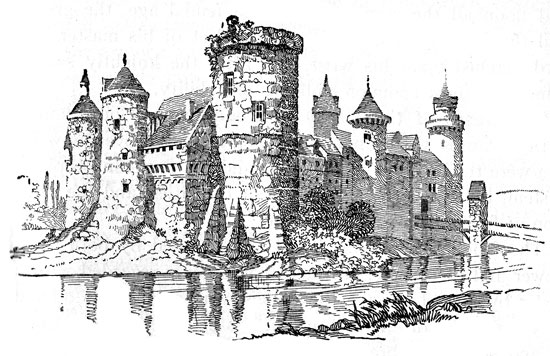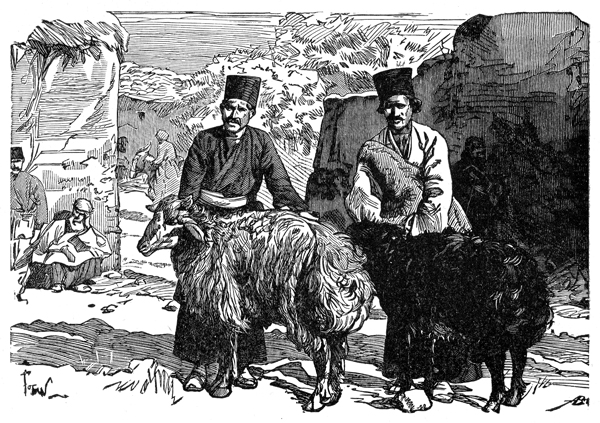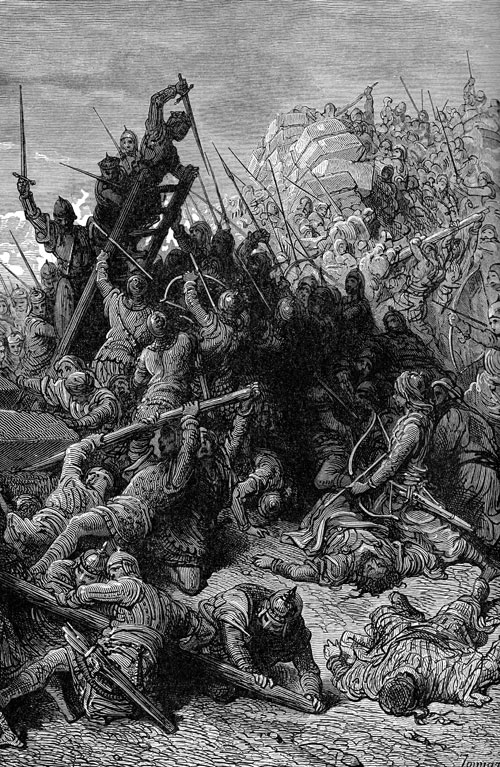 |
| So this is what Lord Fear's been doing since Knightmare ended. |
A blog about writing gamebooks. My musings on how to write a gamebook and what makes a good gamebook. Create your story here!
Sunday, February 26, 2012
Great interactive fiction on Youtube
Friday, February 24, 2012
Yes - I've finally sold out or: It used to be all about the music, man.
I've made some changes to the blog today - I've added a poll, an email subscription link and my April A to Z picture. I intend to do it again as it was a great way to look at lots of new blogs. I was blog 714 to sign up so there's a lot to look at.
I've also added an ad. Yes, I'm monetizing. I didn't want to for a while as I just wanted to sell gamebooks but, in my endless quest to listen to every podcast ever made, I stumbled across Pat Flynn's blog and podcast called Smart Passive Income.
His podcast and blog have given me some great ideas and tips for getting income quite easily and by putting in very little effort. The obvious one is using ads. Another one is the use of affiliate links. I've linked to a lot of products that I love in this blog, but I never knew that Amazon had an affiliate links program. What this means is that if I sign up as an affiliate, I can get links to all the products on Amazon. If anyone buys a product from one of my affiliate links, I get some commission. It will not cost you anything else.
Pat Flynn also told me to tell you that I'm using affiliate links, so that is what I'm doing. I'm going through old posts and adding some affiliate links to Amazon. From now on, if you click on a link that leads to Amazon, it will be an affiliate link and if you buy a product from that link, then I will get commission. You will not need to pay anything extra and I thank you very much for buying your product in a way that makes me a little extra money.
 The podcast also suggested that Infobarrel is a way of earning some passive income. Infobarrel is a site where you write articles and your get money if people click the ads on your article. Since you cannot add articles that you cannot find elsewhere on the web, I won't be writing much about gamebooks on Infobarrel (I might write an introduction to what a gamebook is at some point). My profile has only one post at the moment and this is about avoiding mistakes in A level chemistry questions about ionisation energy. I will also be writing other posts on Infobarrel so watch this space.
The podcast also suggested that Infobarrel is a way of earning some passive income. Infobarrel is a site where you write articles and your get money if people click the ads on your article. Since you cannot add articles that you cannot find elsewhere on the web, I won't be writing much about gamebooks on Infobarrel (I might write an introduction to what a gamebook is at some point). My profile has only one post at the moment and this is about avoiding mistakes in A level chemistry questions about ionisation energy. I will also be writing other posts on Infobarrel so watch this space.
So there we go. Please don't be mad at me for trying to get money for what I do. I still love gamebooks and want their babies and ?I still love you, my readers, but I also want to see just how far I can take my blog, twitter feed, Youtube channel and god knows what else. I'm not expecting millions, I'm just curious.
On Sunday, I'll be writing about my explorations of Youtube for interactive fiction. Until then, you can get your gamebook fix from several places:
Fighting Fantazine Issue 8
Trollzine 4
Andrew Wright's new review at Lone Tiger Gamebook Reviews.
Two time highly commended Windhammer contender Ashton Saylor's new blog.
Until then, happy gamebooking!
I've also added an ad. Yes, I'm monetizing. I didn't want to for a while as I just wanted to sell gamebooks but, in my endless quest to listen to every podcast ever made, I stumbled across Pat Flynn's blog and podcast called Smart Passive Income.
His podcast and blog have given me some great ideas and tips for getting income quite easily and by putting in very little effort. The obvious one is using ads. Another one is the use of affiliate links. I've linked to a lot of products that I love in this blog, but I never knew that Amazon had an affiliate links program. What this means is that if I sign up as an affiliate, I can get links to all the products on Amazon. If anyone buys a product from one of my affiliate links, I get some commission. It will not cost you anything else.
Pat Flynn also told me to tell you that I'm using affiliate links, so that is what I'm doing. I'm going through old posts and adding some affiliate links to Amazon. From now on, if you click on a link that leads to Amazon, it will be an affiliate link and if you buy a product from that link, then I will get commission. You will not need to pay anything extra and I thank you very much for buying your product in a way that makes me a little extra money.
 The podcast also suggested that Infobarrel is a way of earning some passive income. Infobarrel is a site where you write articles and your get money if people click the ads on your article. Since you cannot add articles that you cannot find elsewhere on the web, I won't be writing much about gamebooks on Infobarrel (I might write an introduction to what a gamebook is at some point). My profile has only one post at the moment and this is about avoiding mistakes in A level chemistry questions about ionisation energy. I will also be writing other posts on Infobarrel so watch this space.
The podcast also suggested that Infobarrel is a way of earning some passive income. Infobarrel is a site where you write articles and your get money if people click the ads on your article. Since you cannot add articles that you cannot find elsewhere on the web, I won't be writing much about gamebooks on Infobarrel (I might write an introduction to what a gamebook is at some point). My profile has only one post at the moment and this is about avoiding mistakes in A level chemistry questions about ionisation energy. I will also be writing other posts on Infobarrel so watch this space.So there we go. Please don't be mad at me for trying to get money for what I do. I still love gamebooks and want their babies and ?I still love you, my readers, but I also want to see just how far I can take my blog, twitter feed, Youtube channel and god knows what else. I'm not expecting millions, I'm just curious.
On Sunday, I'll be writing about my explorations of Youtube for interactive fiction. Until then, you can get your gamebook fix from several places:
Fighting Fantazine Issue 8
Trollzine 4
Andrew Wright's new review at Lone Tiger Gamebook Reviews.
Two time highly commended Windhammer contender Ashton Saylor's new blog.
Until then, happy gamebooking!
Sunday, February 19, 2012
My experiences of the Fool God or: Why I didn't finish writing a book when I'd finished the writing
I was very glad to have finally published a gamebook. Temple of the Fool God contained a lot of firsts for me - first use of the Tunnels and Trolls system, first gamebook with art and my first gamebook that I published on RPGNow. It was also the first book where I realised that once the writing is over, there is still a lot more of stuff to do with a book. Stuff I used to consider to be less fun than the writing but still needs to be done as it is very important such as proof reading, formatting, playtesting, inserting hyperlinks and publishing. I used to consider it a tedious add on, but now that I've done these things a few times, I don't mind doing them now and actually even enjoy them.
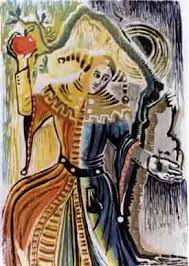 The idea
The idea
I got the idea of the dungeon's theme from my thoughts and reading on the trickster. I wanted trickster characters, trickster races and even the dungeon to act like a trickster. I had the idea of a kingdom where the king is being advised by fools from both the idea of fools in Tudor times and the idea of the Shakespearean fool, especially the fool in King Lear who speaks to King Lear wisely yet escapes punishment because he is a fool. There was also the idea of the wise fool in the middle ages who through their innocence and simplicity would be closer to God and could therefore impart wisdom.
Writing
I had read a few TnT solos and most of them were either only suitable for warriors or for wizards. Rogues weren't particularly good at either book, so I wanted a system that could incorporate both magic and fighting. It was for this reason that I went through the spell list and came up with uses for spells that did not need to be referenced in the text. In Temple of the Fool God, I came up with a list of spells that could be used before combat and decided that the find object spell could be used to add 1 to the treasure table roll in order to get more treasure. That meant that there were fewer spells to reference in the text. I managed to get at least one use for most other spells. I gave a list of spells that weren't going to be used in the solo so that rogues wouldn't choose a useless spell.
I also came up with a talent for each stat that would be useful in the solo and stated that the player could swap their current talent for one used in the book. In future solos, I will have a wider range of talents.
I filled the dungeon with all the references to fools and tricksters I could find. I tried to make the logic of the dungeon quite contrary to normal thought. I hope it worked. I especially enjoyed the encounter before the Fool God himself.
Artwork
This was the first gamebook I wrote that I have put artwork in. I used public domain art from the following sites:
http://karenswhimsy.com/ - Scott Malthouse directed me here.
http://openclipart.org/ - jonny_automatic had a lot of good clipart for me to use.
http://www.pdclipart.org/
In future, have the situation fit the art. - I like working with restrictions. I can't work with a blank slate. Restrictions breed creativity.
Since writing Temple of the Fool God, I have discovered another public domain clipart site - http://etc.usf.edu/
Publishing
I went through Lulu and RPGNow. They were both straightforward. Lulu required a bit of fiddling - the font had to be embedded and the image had to be 595 by 841pixels but they gave very clear, straightforward instructions on how to get your book online.
So there we go. You can buy Temple of the fool God from here but I would like to write more TnT solos in future.
Happy gamebooking!
I got the idea of the dungeon's theme from my thoughts and reading on the trickster. I wanted trickster characters, trickster races and even the dungeon to act like a trickster. I had the idea of a kingdom where the king is being advised by fools from both the idea of fools in Tudor times and the idea of the Shakespearean fool, especially the fool in King Lear who speaks to King Lear wisely yet escapes punishment because he is a fool. There was also the idea of the wise fool in the middle ages who through their innocence and simplicity would be closer to God and could therefore impart wisdom.
Writing
I had read a few TnT solos and most of them were either only suitable for warriors or for wizards. Rogues weren't particularly good at either book, so I wanted a system that could incorporate both magic and fighting. It was for this reason that I went through the spell list and came up with uses for spells that did not need to be referenced in the text. In Temple of the Fool God, I came up with a list of spells that could be used before combat and decided that the find object spell could be used to add 1 to the treasure table roll in order to get more treasure. That meant that there were fewer spells to reference in the text. I managed to get at least one use for most other spells. I gave a list of spells that weren't going to be used in the solo so that rogues wouldn't choose a useless spell.
I also came up with a talent for each stat that would be useful in the solo and stated that the player could swap their current talent for one used in the book. In future solos, I will have a wider range of talents.
I filled the dungeon with all the references to fools and tricksters I could find. I tried to make the logic of the dungeon quite contrary to normal thought. I hope it worked. I especially enjoyed the encounter before the Fool God himself.
Artwork
 |
| Thanks to Murray for introducing me to this picture. |
http://karenswhimsy.com/ - Scott Malthouse directed me here.
http://openclipart.org/ - jonny_automatic had a lot of good clipart for me to use.
http://www.pdclipart.org/
In future, have the situation fit the art. - I like working with restrictions. I can't work with a blank slate. Restrictions breed creativity.
Since writing Temple of the Fool God, I have discovered another public domain clipart site - http://etc.usf.edu/
Publishing
I went through Lulu and RPGNow. They were both straightforward. Lulu required a bit of fiddling - the font had to be embedded and the image had to be 595 by 841pixels but they gave very clear, straightforward instructions on how to get your book online.
So there we go. You can buy Temple of the fool God from here but I would like to write more TnT solos in future.
Happy gamebooking!
Sunday, February 12, 2012
Trickster races in RPGs and gamebooks
Kender
The Kender are a race of short humanoids in the Dragonlance series of novels. They are all basically kleptomaniac, hyperactive children and they are seen as little more than a nuisance. However, these qualities can still help a kender become a great hero as Tasslehoff Burrfoot has shown. His lack of fear, insatiable curiosity and ability to 'borrow' things made him pivotal in saving Krynn from all kinds of dark fates from Evil Wizards to Gods.
Elvins
Elvins are mischevious and vicious little creatures which you may come across while trying to retrieve the Crown of the Kings. You might find a group of them at night who lead you into all kinds of sticky situations. Later on, a large group of them will try to pelt you with acorns.
Leprachauns
Leprachauns are a tricky lot to be sure. You can come across one in the Citadel of Chaos (for those of us who remember paper books, you can get them here) and he enjoys playing all kinds of pranks on you. You could get angry, but that just makes things worse. You finally get rid of him and go through a door only to find yourself in complete blackness being attacked by a strange beast which is impervious to your magic. You black out as its jaws close around your throat and seems like it's all over. Then you wake up only to find out that it is yet another practical joke. Inexpicably, you have no choice but to find your demise funny and the leprachaun gives you a magic sword that increases your attack strength (which is just as well because the hand buzzer reduced your skill) and a mirror. It turns out that you part best of friends.
Gnomes
Gnomes are also a race that you don't want to mess with. You come across a gnome in Darkwood Forest who is quietly sitting on a giant mushroom. If you decide to attack him, your sword turns into a carrot. If you throw it at the gnome, the sword turns into a butterfly.
Shape changers
 Changing shape is a skill that many tricksters possess. Shape changers also come in all shapes and sizes (pun intended) depending on the world that they live in. On Titan, common shapechangers are humanoid lizards who disguise themselves as a child or poor old man to trick people into coming closer. On Magnamund, the Helghast are powerful undead that can shapechange. In Dungeons and Dragons, shapechangers are more intelligent. The ability to shapechange is like the ultimate disguise and, when used well, can cause a lot of damage. You also find carniverous shapechangers that look like chests or doors but are actually blobs of goo.
Changing shape is a skill that many tricksters possess. Shape changers also come in all shapes and sizes (pun intended) depending on the world that they live in. On Titan, common shapechangers are humanoid lizards who disguise themselves as a child or poor old man to trick people into coming closer. On Magnamund, the Helghast are powerful undead that can shapechange. In Dungeons and Dragons, shapechangers are more intelligent. The ability to shapechange is like the ultimate disguise and, when used well, can cause a lot of damage. You also find carniverous shapechangers that look like chests or doors but are actually blobs of goo.
Djinn
Djinn or genies are generally thought of as great as they can grant wishes - anything you want! However, in reality, the djinn will probably try to twist your wish by interpreting it literally or by putting some kind of other twist on it. Sometimes, the wisher is silly and the djinn doesn't need to do anything nefarious to mess up the wish. For example in the Fighting Fantasy RPG, you could find a room where players' expectations come true, but if they start to expect gamebreaking things such as a magical sword of slay all, then the referee should come up with an excuse why it can't be used such as 'It's too heavy'.
There are only a few occasions where a djinn may do something useful such as in Caverns of the Snow Witch where you save a djinn from being trapped in a crystal and being forced to use its magic to help an illusionist. If you free it, it will turn you invisible when you need help. This actually does help.
Noodric Noodnic
The Noodric are giant mice that live on Aon, the world of Lone Wolf. You famously encounter them in book 2 and if you do not have a magic spear to kill the Helghast, having the animal companionship skill to communicate with them is the only way that you will reach Durenor without the magic spear which you probably gave away as an act of kindness earlier on. They are quite mischevious and although they show through the mountain, they also steal your money.
Fey
The gamebooks and RPGs which involve Dave Morris as a writer are usually set in a human centric world where non human races are inscrutable and unpredictable. In fabled Lands, I once found a Fey shop where I could exchange shards for Fey money, but if I did not have any Fey money, I would lose. Fey creatures are also present in the Dragon Warriors RPG where there are many mischecious sprightly creatures. For example, Goblins are cruel magic users who relish in mischief which contrasts with Titans's ugly low intelligence footsoldiers of evil.
Next week, we will look at some trickster character classes. Until then, happy gamebooking!
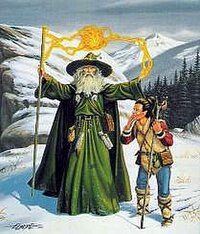 |
| Is defeating evil going to be fun, Fizban? |
The Kender are a race of short humanoids in the Dragonlance series of novels. They are all basically kleptomaniac, hyperactive children and they are seen as little more than a nuisance. However, these qualities can still help a kender become a great hero as Tasslehoff Burrfoot has shown. His lack of fear, insatiable curiosity and ability to 'borrow' things made him pivotal in saving Krynn from all kinds of dark fates from Evil Wizards to Gods.
Elvins
Elvins are mischevious and vicious little creatures which you may come across while trying to retrieve the Crown of the Kings. You might find a group of them at night who lead you into all kinds of sticky situations. Later on, a large group of them will try to pelt you with acorns.
They're after me lucky charms. |
Leprachauns are a tricky lot to be sure. You can come across one in the Citadel of Chaos (for those of us who remember paper books, you can get them here) and he enjoys playing all kinds of pranks on you. You could get angry, but that just makes things worse. You finally get rid of him and go through a door only to find yourself in complete blackness being attacked by a strange beast which is impervious to your magic. You black out as its jaws close around your throat and seems like it's all over. Then you wake up only to find out that it is yet another practical joke. Inexpicably, you have no choice but to find your demise funny and the leprachaun gives you a magic sword that increases your attack strength (which is just as well because the hand buzzer reduced your skill) and a mirror. It turns out that you part best of friends.
Gnomes
Gnomes are also a race that you don't want to mess with. You come across a gnome in Darkwood Forest who is quietly sitting on a giant mushroom. If you decide to attack him, your sword turns into a carrot. If you throw it at the gnome, the sword turns into a butterfly.
Shape changers
 Changing shape is a skill that many tricksters possess. Shape changers also come in all shapes and sizes (pun intended) depending on the world that they live in. On Titan, common shapechangers are humanoid lizards who disguise themselves as a child or poor old man to trick people into coming closer. On Magnamund, the Helghast are powerful undead that can shapechange. In Dungeons and Dragons, shapechangers are more intelligent. The ability to shapechange is like the ultimate disguise and, when used well, can cause a lot of damage. You also find carniverous shapechangers that look like chests or doors but are actually blobs of goo.
Changing shape is a skill that many tricksters possess. Shape changers also come in all shapes and sizes (pun intended) depending on the world that they live in. On Titan, common shapechangers are humanoid lizards who disguise themselves as a child or poor old man to trick people into coming closer. On Magnamund, the Helghast are powerful undead that can shapechange. In Dungeons and Dragons, shapechangers are more intelligent. The ability to shapechange is like the ultimate disguise and, when used well, can cause a lot of damage. You also find carniverous shapechangers that look like chests or doors but are actually blobs of goo.Djinn
 |
| You think I wanted a 12 inch pianist? |
There are only a few occasions where a djinn may do something useful such as in Caverns of the Snow Witch where you save a djinn from being trapped in a crystal and being forced to use its magic to help an illusionist. If you free it, it will turn you invisible when you need help. This actually does help.
 |
| With a guest appearance from the cast of Redwall. |
The Noodric are giant mice that live on Aon, the world of Lone Wolf. You famously encounter them in book 2 and if you do not have a magic spear to kill the Helghast, having the animal companionship skill to communicate with them is the only way that you will reach Durenor without the magic spear which you probably gave away as an act of kindness earlier on. They are quite mischevious and although they show through the mountain, they also steal your money.
Fey
The gamebooks and RPGs which involve Dave Morris as a writer are usually set in a human centric world where non human races are inscrutable and unpredictable. In fabled Lands, I once found a Fey shop where I could exchange shards for Fey money, but if I did not have any Fey money, I would lose. Fey creatures are also present in the Dragon Warriors RPG where there are many mischecious sprightly creatures. For example, Goblins are cruel magic users who relish in mischief which contrasts with Titans's ugly low intelligence footsoldiers of evil.
 |
| He could get a bit spiky. |
Sunday, February 5, 2012
Famous tricksters
 |
But things happened and there
was stuff and
shenanigans.
Beautiful word. Shenanigans.
|
Here are some tricksters from both mythology and modern media and all of the crazy shennanigans that they got up to.
The Doctor could be considered a trickster for reasons that are too numerous to list here as he usually involves overthrowing despotic regimes throughout time and space.
Anansi
Anansi tales come from the Ashanti tribe in West Africa. Anasi is famous for getting into all kinds of trouble. One of his most famous stories involves him trying to steal of the World's wisdom and trying to hide it up a tree. However, he can't drag the pot up on his own until a child suggests that he ties it to his back. He then drops the pot and the wisdom gets spread throughout the World. Anasi is a bit dim.
There are plenty of other stories involving Anasi and all of the trouble that he gets into. Some of them involve his schemes falling flat on their face such as the tale of Anansi and the fisherman.
Loki
Loki was not a nice trickster. He managed to get the most beloved of the Norse gods, Baldr. Baldr was so loved amongst the gods that everything had sworn never to harm him. Everything, that is, except miseltoe. Loki found some misletoe and returned to the gods who were enjoying themselves by throwing all manner of weapons at Baldr and watching them bounce off. Hod, Baldr's brother, who was blind, was not able join in with the 'festivities'. Loki helpfully let Hod fire a miseltoe at Baldr which killed him and upset the rest of the gods. Loki ended up being bound to a rock by his son's entrails and having a snake drip its poison into his mouth.
If there's one thing that could be said about the ancient gods it's that they really know how to sort out their punishments.
Wile E. Coyote and Roadrunner
 |
| Meep meep! |
The premise could not be simpler. A coyote chases a roadrunner. How could you devote so much cartoon time to such a thing? Well, as it seems, you can. All you need is a roadrunner, a coyote, a road, a desert and a company that seems to make literally anything. When it involves anything as simple as catching a roadrunner, no one is as talented as coyote when it comes to thinking up increasingly more elaborate and bizarre schemes. Unfortunately, cartoon physics is Coyote's worst enemy and it regularly injures and humiliates him. However, thankfully for us, Coyote just won't give up and this winning formula has provided us with hours of quality entertainment. I guess there are three tricksters in the cartoon - Coyote, Roadrunner and the cartoon itself.
Q could literally pop up in any time and place. He is an omnipotent being who can control time and space, but the use of his powers seems to extend to wearing silly costumes, stealing Captain Picard's chair and taking the mick out of his crew. He appears in the first Star Trek: Next Generation episode and puts humanity on trial for behaving in a primitive and brutal fashion. He also appears when he gives Riker Q powers to learn from humanity, when he loses his powers, when he discovers a member of the Q living as a human, when he hurls the Enterprise through space to warn them of the Borg and in the finale to help save humanity. He also appears when Picard is being operated on but that may be a hallucination. Q is sometimes a hindrance, sometimes a help but he is always an irritaton. Although Q is sometimes helpful, he never helps in a straightforward way and only does so after setting little tests for Picard.
So that's it for some famous tricksters. Next week, I'll write about some RPG races with trickster qualities.
Until then, happy gamebooking!
Thursday, February 2, 2012
More online gamebooky goodness
Good evening to you all! I hope you are well. Well this will make things even better. Here's the first good thing. In case you didn't know, the Chronicles of Arborell website runs a gamebook competition every year where people get to enter short gamebooks to be judged. I always enjoy reading the excellent entries. This year, I especially enjoyed Peledgathol, the Last Fortress, written by Ashton Saylor who also wrote The Gates of Heaven and Hell in the previous year.
Well, Ashton has put his gamebooks on his blog and, in addition to his Windhammer entries, there are two more, as yet unseen gambooks on his page.
One, The Grimlock's Cave is a Fighting Fantasy adventure that also uses some Sorcery! spells. The second new book, Castle of Bones is a poignant tale where you must destroy an evil sorceress who has killed most of your family and taken your castle.
All of Ashton's gamebooks are worth a read as is his blog and his games page.

In other news, ever since Scott Malthouse and his Trollish friends introduced me to some great public domain art websites (http://karenswhimsy.com/, http://openclipart.org/ and http://www.pdclipart.org/) to use for Temple of the Fool God, I've been really enjoying looking through the pictures. Thanks guys!
Dave Morris and Jamie Thomson are giving away Frankenstein's Legions away for free for a limited period.
And finally, Tin Man Games is releasing a Scifi gamebook!
It seems that Neil Rennison is right when he said that 2012 will be the year of the gamebook.
Happy gamebooking!
Well, Ashton has put his gamebooks on his blog and, in addition to his Windhammer entries, there are two more, as yet unseen gambooks on his page.
One, The Grimlock's Cave is a Fighting Fantasy adventure that also uses some Sorcery! spells. The second new book, Castle of Bones is a poignant tale where you must destroy an evil sorceress who has killed most of your family and taken your castle.
All of Ashton's gamebooks are worth a read as is his blog and his games page.

In other news, ever since Scott Malthouse and his Trollish friends introduced me to some great public domain art websites (http://karenswhimsy.com/, http://openclipart.org/ and http://www.pdclipart.org/) to use for Temple of the Fool God, I've been really enjoying looking through the pictures. Thanks guys!
Dave Morris and Jamie Thomson are giving away Frankenstein's Legions away for free for a limited period.
And finally, Tin Man Games is releasing a Scifi gamebook!
It seems that Neil Rennison is right when he said that 2012 will be the year of the gamebook.
Happy gamebooking!
Wednesday, February 1, 2012
My rules for Tunnels and Trolls solos
I enjoyed writing my first Tunnels and Trolls solo very much and I would like to write another one. However, I also want to incorporate as many of the game rules as possible into my solo. for example, it is very hard to accommodate both wizards and warriors in a solo. These rules below are my attempt to incorporate more options into TnT solo adventures. Please comment on them.
Talents
Below is a list of talents that may be used in TnT solo
adventures written by me. You may add
the bonus of any talent you have when making a saving throw if you see the name
of the talent in parentheses after the saving throw instruction. For example, ‘Make a L1SR on STR (Labouring,
Smithing) means that you must make an SR on strength and add your bonus for
labouring if you have it and smithing if you have it (so you may get the
bonuses from more than one talent as they may involve overlapping skills).
The talents that will be used in my TnT solos are:
STR: Labouring, Climb, Swim, Smithing, Break bonds,
Wrestling, Powerful punch, Charge!, Smash weapon.
CON: Survival, Iron stomach, Healing, Forced march, Poison
resistance, Disease resistance, Ascetic, Resist cold, Resist heat, Thick skin.
DEX: Acrobatics, Pick lock, Sneak, Riding, Balance, Use
rope, Escape artist, Disarm opponent, Thievery, crackshot, archery, throwing.
SPD: Dodging, Sprint, Quick draw, Unconscious defence, Arrow
catch, Deflect missile, ambush.
INT: Appraise,
Strategy, Plant lore, Artifice, Alchemy, Decipher script, First Aid, Symbol
lore, Religion lore, Architectural lore, Spot weakness.
WIZ: Sense magic, Intuit danger, Sense wizard,
Synchronicity, Blindsense, Hypnotism, Sense changeling, Fae law, Divination,
Gut feeling, combat prediction.
LK: Gambling, Just what I need, Narrow escape, Wild
guesswork, Unlikely encounter, Coincidence, Just as I wanted, Impossible shot,
Last minute rescue, Impossible hit.
CHA: Persuasion, Disguise, Calm animal, Con, Haggle,
Intimidate, Etiquette, Amazing performance, Rousing speech, Taunt.
Combat
Before combat, you may either
cast one spell that can be used before combat (see below) or use a ranged weapon. To
hit your opponent, you must perform a L2SR on DEX (crackshot, archery (if using
bows), throwing (if using a thrown weapon)).
Stunts in combat
Combat isn’t just all about wearing down your opponent’s MR
while trying to stop them hitting you.
In a TnT RPG, you can suggest your own stunts to the GM who can work
with you to find out the result.
However, you can’t do that in a solo, so instead you will have stunts
suggested to you. If you fight a combat,
you may be given the option of performing certain stunts. These stunts are saving throws against a
particular attribute (and possibly talent) which may produce an extra effect in
your favour. You may choose to perform a
stunt instead of attacking your opponent.
You still roll dice for yourself and if you lose the round then you
still take damage as normal. If you win,
however, you may decide to perform a stunt rather than inflict damage in the
normal way. You then make the saving
roll. If you succeed, you get the effect
listed. If you fail, nothing
happens. You may try the same stunt
again on the same opponent, but each time, the saving roll level increases by 1
as they become wise to your tricks (If you fight multiple opponents, it still
increases as they can all see what you are up to).
You come up with the story of what you do to pull off such
an effect – a saving roll on INT that allows you to automatically inflict 1
point of spite damage per round may come from you spotting a chink in your
opponent’s armour. A saving roll on STR
that makes your opponent miss two rounds of combat may be because you slammed
your staff into their belly and winded them.
You come up with the action.
Also, sometimes, monsters may try stunts on you! Watch out for that!
Spells
Below is the list of spells form the TnT 7.5 Core Rulebook
and when you may use them. There are
some spells that may be used before combat, some that may only be used when
named in the text, some that may be used at any time and some that may only be
used on a willing target (as you are playing a solo, however, these will almost
never be used). Some spells may be used
in other circumstances. For example the
call flame spell may be used in place of a tinderbox.
Level 1 (INT + DEX 10)
Spells you may use before combat: Call flame, Call water, Dem Bones Gonna Rise,
Hold that Pose (target loses 1st combat round), Oh Go Away (counts
as winning against a single foe. Otherwise, one foe does not take part in
combat for 2 rounds – one to flee, one to get back), TTYF, Vorpal Blade,
Spells you may use on another, willing target (not too
useful): Cremme de la Kremm, Teacher,
Suppress Kremm,
Spells you may use on any paragraph you are not fighting or
performing a saving roll: Hocus Focus,
Spells you may only use when the text demands: Detect Magic, Know your foe, Lock Tight, Oh
There it is, That’s a Natty Beard, Who’s There?, Will o Wisp,
Other notes:
Call flame: Can be
used in place of a tinderbox or when lighting a fire.
Call water: Can be
used in place of a waterskin or when putting out a fire.
Knock Knock: Can be
used when there is a L1SR to pick a lock.
Level 2 (INT + DEX 12)
Spells you may use before combat: Glue You, Hidey Hole,
Little Feets, Spirit Mastery (can then use the enslaved monster to fight
another monster. If the hero’s
characteristics go below the MR of the monster, they must fight the monster
then), Unerring Blade, Unlucky Bees, Whammy.
Spells you may use on another, willing target (not too
useful):
Spells you may use on any paragraph you are not fighting or
performing a saving roll: Dura Spell Battery,
Spells you may only use when the text demands: Cateyes, Ding a Ling, Find Object, Mirage, Omnipotent
Eye,
Other notes:
Hidey Hole: Doubles
an attribute for the purposes of hiding or sneaking SRs.
Little Feets: Doubles
an attribute for the purposes of running SRs.
Poor Baby: Can be
cast on any paragraph the hero is not fighting or performing another SR.
Level 3 (INT + DEX 15)
Spells you may use before combat: Befuddle (If multiple opponents, target
fights another one for 3 turns, otherwise no action for 3 turns), Blasting
Power, Fire at Will, Firestorm of Protest (only used on multiple opponents –
you may flee while they argue), Freeze Please, Rock a bye (puts 1 target out of
action, may flee), Shield Me,
Spells you may use on another, willing target (not too
useful)
Spells you may use on any paragraph you are not fighting or
performing a saving roll:
Spells you may only use when the text demands: Devoted Rain
Cloud, Dis-Spell, Find Person, Firestorm of Protest, Fly me, Hard Stuff,
Slash-Yuck.
Other notes:
For What it’s worth:
Caster can use this whenever there is an SR that the appraise skill
could be used for. They will
automatically pass it.
Healing Feeling: Can
be used on any paragraph that does not involve combat or another SR.
Level 4 (INT + DEX 19)
Spells you may use before combat: Double Double, Protective
Pentegram (may cast two more spells on self or flee unharmed), Smog,
Spells you may use on another, willing target (not too
useful)
Spells you may use on any paragraph you are not fighting or
performing a saving roll:
Spells you may only use when the text demands: Dum Dum, Upsidaisy
Other notes:
Double Double: Can be
used for any SR. The halving only lasts
on the next paragraph.
Too Bad Toxin: Can be
used on any paragraph that does not involve combat or another SR.
Spells you may use before combat: Breaker Breaker, Mind Pox, Trollgod’s
Blessing, Zingum (escape combat),
Spells you may use on another, willing target (not too
useful)
Spells you may use on any paragraph you are not fighting or
performing a saving roll: Resist Magic (lasts the whole gamebook or until you get a spell cast upon you, may not restore WIZ
while in operation),
Spells you may only use when the text demands: Dear Lord, ESP, Second Sight, Zingum,
Other notes:
Level 6 (INT + DEX 30)
Spells you may use before combat: Blue Shirt of Life, Reversal of Fortune,
Spells you may use on another, willing target (not too
useful)
Spells you may use on any paragraph you are not fighting or
performing a saving roll:
Spells you may only use when the text demands: Mystic Visions, Porta Vision,
Other notes:
Level 7 (INT + DEX 37)
Spells you may use before combat: Zappathingum
Spells you may use on another, willing target (not too
useful)
Spells you may use on any paragraph you are not fighting or
performing a saving roll:
Spells you may only use when the text demands: Invisible Wall
Other notes:
Level 8 (INT + DEX 45)
Spells you may use before combat: Zapparmour
Spells you may use on another, willing target (not too
useful)
Spells you may use on any paragraph you are not fighting or
performing a saving roll: Patterns of
Cosmic Fate
Spells you may only use when the text demands: Imafrawg
Other notes:
Imafrawg – can be used to automatically succeed at any
disguise SR.
Zombie Zonk – can be used on the body of an opponent after
combat.
Level 9 (INT + DEX 54)
Spells you may use before combat: Death Spell #9, Medusa, Yerafrawg (auto win
against 1 opponent)
Spells you may use on another, willing target (not too
useful)
Spells you may use on any paragraph you are not fighting or
performing a saving roll: Mortal Source
Spells you may only use when the text demands: Pygmalion
Other notes:
Level 10 (INT + DEX 64)
Spells you may use before combat: Hellbomb Burst, Smaller is Smarter,
Spells you may use on another, willing target (not too
useful)
Spells you may use on any paragraph you are not fighting or
performing a saving roll:
Spells you may only use when the text demands: Blow Me To..., Wizard Speech
Other notes:
Level 11 (INT + DEX 75)
Spells you may use before combat: Bigger is Better, Blow You To (auto win, no
treasure)
Spells you may use on another, willing target (not too
useful)
Spells you may use on any paragraph you are not fighting or
performing a saving roll:
Spells you may only use when the text demands: Cut the Cord, Ghostly Going
Other notes:
Level 12 (INT + DEX 87)
Spells you may use before combat: Banishing (only against demons), Invisible
Fiend, Summon,
Spells you may use on another, willing target (not too
useful)
Spells you may use on any paragraph you are not fighting or
performing a saving roll:
Spells you may only use when the text demands: Nefarious Necromancy, Omniflex,
Other notes:
Spells you may use before combat:
Spells you may use on another, willing target (not too
useful)
Spells you may use on any paragraph you are not fighting or
performing a saving roll: Born again
Spells you may only use when the text demands:
Other notes:
Recovering WIZ
You may recover 1 point of WIZ on any paragraph that does
not involve a combat or a saving roll.
If there is an * by the paragraph number, you may restore your WIZ to
its initial level (this will be due to a long period of time passing over that
paragraph).
Adventure points
in a solo
The number of adventure points you are awarded in a solo
depends on the following factors.
Monsters defeated = MR
Saving rolls = Dice roll x SR level
Casting magic = WIZ points expended.
Completion of adventure = number allocated.
Does anyone have any comments?
Subscribe to:
Posts (Atom)








